Definitive Quarantine Article
From time to time, you will need to be able to keep fish outside of the main pond, for either quarantine or treatment. What is often overlooked is the simple fact that this containment must be as “fish friendly” as the pond itself, if not more so. While an inadequate Q (quarantine) or T (treatment) tank will protect the fish in the main pond from the fish in the Q or T tank, those isolated fish stand little chance of survival. – Mike Singleton
Why, How and When to Quarantine Your New Fish Purchases
Since the Q and T tanks have so much in common, I’ll speak of them as if they were indeed, one in the same. Point of fact, for many people, these two types of isolation tanks *will* be one in the same. For now, lets call them by a single name, the QT tank.
The idea of quarantining new fish before adding them to the main pond should not be considered as anything less than mandatory. Failure to see it that way puts your entire collection at risk. It doesn’t matter if your fish are “pond mutts” or high-end, show quality Koi. There is no reason to risk loosing them all to an “imported” disease. People will tell you that they never quarantine new fish. About the only thing they have going for them is pure, dumb luck. And that will not last forever. Sooner or later, they will learn the hard way.
There is more than one reason to quarantine newly acquired fish. The reason most people are aware of is to give you time to determine if the fish is healthy and parasite-free. But consider how your fish came to you.
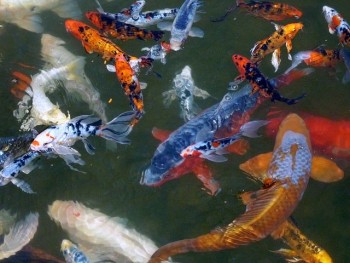 If they are imports, they’ve likely had a rough time of it. The real high-end Koi don’t have it so bad, as they are pampered all the way from the breeder, to your pond. But the majority of imported Koi will have been stressed beyond belief, before you get them. They will have been moved a number of times, without being fed, or allowed to recover from the previous move. And then there’s the long flight in a crowed bag. Once in the country, they may undergo several more moves before the dealer gets them. A good dealer will allow the fish time to recover from all that stress, before offering them for sale. A large number of them will sell them as quickly as possible, however.
If they are imports, they’ve likely had a rough time of it. The real high-end Koi don’t have it so bad, as they are pampered all the way from the breeder, to your pond. But the majority of imported Koi will have been stressed beyond belief, before you get them. They will have been moved a number of times, without being fed, or allowed to recover from the previous move. And then there’s the long flight in a crowed bag. Once in the country, they may undergo several more moves before the dealer gets them. A good dealer will allow the fish time to recover from all that stress, before offering them for sale. A large number of them will sell them as quickly as possible, however.
Domestic Koi won’t go through quite as much of that, but still enough to place the fish under a considerable amount of stress. *Any* Koi bought at a Koi show should be thought of as a “high-risk purchase.” This would be due to the obvious stress involved with the fish being moved and being kept in very crowded conditions in water of doubtful quality. Then there is always the chance of cross-contamination with water from the other tanks at the show. This can be as obvious as children (or child-like adults) putting their hand into every tank they come to, or something less obvious, such as airborne mist from the inevitable splashing that occurs.
The Quarantine Period is a *Recovery Period* that lets the fish “rest up” and get back to “normal.” The post-shipment period finds the fish very stressed out and this stress *will* suppress the immune response. This shipment stress and it’s effect on the fish’s ability to fight disease is the underlying cause of the *myth* that imported Koi are somehow “less hardy” than domestic Koi. Send a domestic Koi on the same journey and it will wind up the same way, severely stressed and ready to die with the least provocation.
Give these fish an environment that allows them to feel safe, with excellent water quality, and they *will* recover. Just like a person with “jet lag,” they need to “rest up and catch up.” Their immune systems will begin to function again and if kept in a facility that is parasite-free, with well filtered water, and nothing to cause them to go into a “flight or fight” mode, they will do well. The most important thing they will need during this phase is *stability*. No changes in *anything.* Change equals stress and they’ve had more than enough of that! Your QT system needs to be able to supply them with that stability for the first week or so with minimal intrusion.
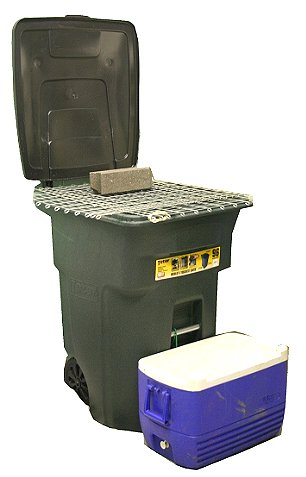 Note: All QT tanks should be netted, to keep frightened fish from jumping out, as well as to keep predators out and foreign materials from dropping in. Providing some sort of cover for the fish to hide in will reduce the likelihood of jumping, as well as making the fish feel more secure. But this cover should not be something the fish could land on and be stranded, should it decide to jump anyway.
Note: All QT tanks should be netted, to keep frightened fish from jumping out, as well as to keep predators out and foreign materials from dropping in. Providing some sort of cover for the fish to hide in will reduce the likelihood of jumping, as well as making the fish feel more secure. But this cover should not be something the fish could land on and be stranded, should it decide to jump anyway.
After that first week (or two,) the more commonly thought of part of quarantine can begin. This is where you start looking for things that could threaten your main population of fish, such as on-going disease or the presence of parasites. Care should be taken to accurately *identify* the specific disease or parasite that needs attention, so that the *least* intrusive treatment can be given. If none have been found, then simply *observe* the new fish for several weeks. If after three or four weeks nothing has been found, good! But don’t add them to the pond, just yet.
With the newly discovered diseases and harder to kill strains of parasites, many have begun to advocate prophylactic treatments. These are treatments for parasites not actually observed, but “just in case” they are present and missed during a microscopic exam. I’m beginning to find myself thinking more along those lines, myself. But if this is to be done, it should be after a long Q period that has the fish being fully recovered and better able to withstand the treatment. *Not* something done during that first two weeks of “recovery.”
(See note)
The next thing that should be done and often is not, is the introduction of an expendable “test flyer” (or two) from the main pond, *into* the QT tank. That’s right, move one or two fish *from* the pond, *into* the tank with the new fish. Why? This will let you find out if the normal “background” bacteria that are normal to your new fish, will be a problem for your existing fish. All fish have “resident” bacteria that they are “used to.” Put a child in a new school, and you should not be surprised to find him/her come home with a cold, or at least a simple case of the sniffles. In a short period of time, he/she will get over it and will have adjusted to the new “background bugs.” Same with fish!
The fish from the pond will introduce the pond’s background bacteria to the new fish, and they will also have the chance to sample the new fish’s background bacteria. So, you have to watch *all* the fish in the QT tank. If after two weeks of cohabitation everyone seems fine, start doing partial water changes in the QT tank, replacing the removed water with water *from* the main pond. Once satisfied that nothing new is going on with the new fish once the majority of the water has been changed, then you can move them to the main pond.
One new twist to the equation is the fact that both KHV and SVC (viral diseases) have temperature “triggers.” Things being the way they are these days, serious consideration should be given to including changing the water temperature at a controlled rate to avoid thermal shock to the fish, moving the water temp into the active ranges of both diseases. After the incubation period has passed and everything still looks good, the temp must then be returned to match the pond water temp, again, in a controlled manner, avoiding temperature shock. With any luck at all, your pond will already be within the active range of one disease, so that you’ll only have to worry about the other. (As if one wasn’t enough!)
Doing all this can easily run the Q period well past that oft quoted “3 week” minimum. But the longer, the better. And it should be obvious by now just *why* the QT tank needs to be so much more than a minimum holding tank. It must be every bit as good of an environment as the main pond, itself. And it must be able to keep that high level of quality, for as long as needed.
Now, if this QT tank is being used for treating a fish, or several fish, it still needs to be a high-quality environment, but not for such an extended period as when used for quarantining new fish. If you were treating the fish with injectable antibiotics, the fish would typically be returned to the main pond in five days, or less. At the end of the injection series, you should be seeing definite signs of healing. There is no need to keep the fish out of the main pond after this point. In fact, the fish will heal much quicker when returned to the main pond.
Many simply catch the fish and inject them, without removing the fish to a treatment tank. What is not widely known by hobbyist is that a larger percentage of whatever antibiotic is injected may be passed into the water through excrement, virtually unchanged. This introduces a low-level of antibiotics into the water that can expose pathogenic bacteria in the pond, to a sub-lethal dose. And in smaller ponds where dilution is incomplete, that may be one way that drug-resistant diseases can come into being.
Another benefit of using a treatment tank for antibiotic treatments is that the fish will under less stress, as it should be relatively simple to catch them for the injections. Chasing a single fish around a large pond will not only stress the fish being sought, but the rest of the population, as well.
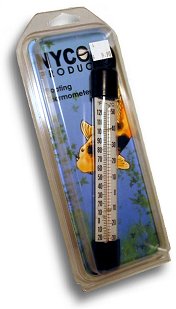 Water temperature is critical during antibiotic use! At a temperature of 65*F or less, antibiotics may be of limited use due to the fishes’ slow metabolism*. Ideally, you want the water temperature to be in the 74*F to 78*F range. It is relatively easy and inexpensive to warm up a QT tank, especially when compared to heating an entire pond. Large aquarium heaters can be used, or stock tank heaters for larger QT tanks. I’ve heard of one person that built a QT tank that incorporated a waterbed heater under the liner! (If you think about that one for a minute, it won’t sound quite so crazy.) Just remember that warmer water will hold less oxygen than cold water, so aeration is important.
Water temperature is critical during antibiotic use! At a temperature of 65*F or less, antibiotics may be of limited use due to the fishes’ slow metabolism*. Ideally, you want the water temperature to be in the 74*F to 78*F range. It is relatively easy and inexpensive to warm up a QT tank, especially when compared to heating an entire pond. Large aquarium heaters can be used, or stock tank heaters for larger QT tanks. I’ve heard of one person that built a QT tank that incorporated a waterbed heater under the liner! (If you think about that one for a minute, it won’t sound quite so crazy.) Just remember that warmer water will hold less oxygen than cold water, so aeration is important.
*Germs move more slowly in cold water, which is nice as the Koi immune system is also in slow motion.
Keeping the fish in a QT tank during treatment also makes it much easier to observe the fish for changes in condition. This will make it easier to assess the effectiveness of a treatment and to decide early on, if a change is required should it not work.
Other treatment protocols are of short duration. Having a QT tank ready is handy for short-term treatments, such as Chloramine T or Oxolinic Acid. Here, you can balance the volume of water between two criteria. One, large enough to safely contain the fish for the duration of the treatment and Two, small enough to keep the treatment from being cost-prohibitive.
Some use a QT tank to use one type of treatment on the fish, while doing a much harsher treatment on the pond, itself. It does little good to treat fish for a problem, and then return them to the exact same conditions that allowed or caused the problem, in the first place. Simple concept, but surprisingly *often* overlooked.
Some examples of what can be used for QT tanks:
Stock Tanks. These can be Poly Tanks, Rubbermaid tanks, or a similar tank, often found with the lowest price at farm supply stores. The cone bottom tanks can be set up to be nearly self-cleaning, very easily.
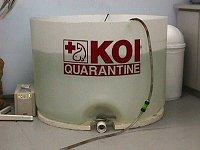 Show Tanks. These can be a bit more expensive, but are excellent for this use. Do keep in mind that some treatments may stain the tank. Their advantage is that they can be folded up when not in use, for storage.
Show Tanks. These can be a bit more expensive, but are excellent for this use. Do keep in mind that some treatments may stain the tank. Their advantage is that they can be folded up when not in use, for storage.
Purpose Built Tanks or Ponds. These could be small ponds of any type, such as a landscape timber pond, with fish kept in them to keep the biofilter active. But you must be able to remove the resident fish when you need it! If you aren’t going to keep fish in it, then you should devise a way to cover it, to keep it empty and clean, while awaiting use.
Improvised Temporary Containment. By this, I mean something as simple as a wire fence used to support a flexible liner. One company I know of sells these in a kit form, from quite small, to very large. If you have the room and are into “self-abuse,” you can simply dig a hole and drop a liner in, even a replacement swimming pool type.
“Kiddy-Pools.” I’m not including those shallow wading pools for very small children, unless you need to quarantine aquatic plants. But the larger pools with rigid sides *can* be used. If you can find one with high sides that isn’t *too* large, it can be useful. The high sides, combined with a net cover, reduce the chances of loss through jumping. Much talk has been directed at the possibility of a chemical added to the vinyl that keeps algae from forming, which would be a problem for fish. But I’ve never actually seen a pool that had such an additive. To be safe, read every printed word on the package, just to make sure. You might even want to give the manufacturer a call, if a number can be found.
Maintaining Water Quality
As previously stated, the water quality in a quarantine or treatment tank *must* be as good as, or *better* than in the main pond. For very short-term, bath-type treatments, this is no problem. If the volume of water is sufficient, all you need do is provide aeration. For longer periods, some form of filtration will be required. Maintaining water quality through water *changes* is not a good idea. Again, think of “change” as “stress.”
Water changes can produce unwanted variations in water temperature, and can make sustaining specific concentrations of a chemical treatment difficult. (Even salt.) Unless the change is in the form of a flow-thru system, it guarantees variations in water *quality*. A flow-thru system would make many chemical treatments impossible.
One of the easiest ways to filter a QT tank is with a chemical filter. At least one type of activated carbon filter is sold as a complete “system” for small ponds. It consists of a submersible pump with a fountainhead (useful for aeration) and a box containing a carbon pad on the pump’s intake. I’ve used a modified version of this setup, several times.
The modification consisted of removing the carbon pad and the “solids filter” pad from the box. A piece of plastic window screen was placed in the box, and loose carbon granules were poured in. The screen was cut large enough so that it could be folded over the carbon, holding it in place. I left just enough space in the box to cover the carbon with a sheet of synthetic air filter material and was just barely able to put the lid back into place. This gave me much more carbon in the filter that what comes in that pad. You might be able to fit more than one pad in the box, if you’d rather not mess with loose carbon.
The problem with a chemical filter using activated carbon is that it *will* remove most any type of bath treatment. If you are going to use a bath treatment, you will have to remove that carbon filter. If you use zeolite instead of carbon, you can run into the same problem, plus you won’t be able to use an elevated salt level, either. The salt can cause the zeolite to dump whatever ammonia it has absorbed.
However, if you are going to be using primarily injectable antibiotics and/or topical treatments, the chemical filter can work well for you. Any chemical treatment that you would use in a pond, that requires bypassing a biofilter for a short term, would be available to you in this QT tank. Instead of bypassing the chemical filter, you would simply remove it from the pump’s intake. The pump would be kept running, to provide circulation and aeration.
Should you decide to use standard biofiltration, all the “rules” that apply to the pond’s system, apply to the QT tank, as well. The filter must be fully “cycled” *before* fish are added. Trying to establish a biofilter while quarantining fish is a short cut to disaster!
Biofiltration
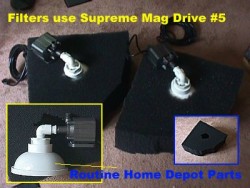 You have a number of options. If your QT system will be using a sponge filter, it can be set up and running in the main pond. Here, it will cycle and add to the pond’s filtration. (Too much filtration is not enough! Sound familiar?) Likewise, most types of bio-media can be place somewhere in the pond or filter system where water will flow through it. When needed, it can then be removed from the pond and placed into the QT’ tank’s biofilter. Another method would be to set up a small bead filter on the main pond and move it to the QT tank, when needed.
You have a number of options. If your QT system will be using a sponge filter, it can be set up and running in the main pond. Here, it will cycle and add to the pond’s filtration. (Too much filtration is not enough! Sound familiar?) Likewise, most types of bio-media can be place somewhere in the pond or filter system where water will flow through it. When needed, it can then be removed from the pond and placed into the QT’ tank’s biofilter. Another method would be to set up a small bead filter on the main pond and move it to the QT tank, when needed.
A submersible pump, or an airlift can power the sponge filter. (Making a home made sponge filter) The simplest form of the latter would be a large, open cell foam sponge, with a hole in the center, running all the way through it. A pipe with an end cap is set down into that hole. The part of the pipe that is inside the sponge should have a number of holes drilled in it. An air stone is placed in the bottom of the pipe. The pipe should extend from the bottom of the sponge, to a point just below the surface of the water. Air bubbling up through the pipe will bring water with it, drawing it in through the sponge. This makes for a nice biofilter that also helps aerate the water and will capture solids, at the same time. It requires a depth of about 18 inches to work really well.
The sponge filter will have to be cleaned, from time to time. I’ve found the best way to do that is to put a plastic fish bag around the filter while it’s still submerged. Push the bag against the sponge to remove excess water, without squeezing the sponge. This makes it easier to lift it from the tank. Once out of the tank, the sponge can be dunked in a bucket of pond water to remove the solids. A gentle squeezing may be needed, but be careful not to *over clean* the filter. You do not want to remove much of the biomass when cleaning the filter. This type of biofilter should not be confused with a sponge-type of mechanical prefilter. The sponge will naturally collect solids, but it’s primary function is to provide surface area for biofiltration bacteria, just like the media any other type of biofilter.
An oversized sponge also can be used as a prefilter on a submersible pump or just about any water intake. Care must be taken to see that this prefilter is not allowed to clog to the point that it impedes the supply of water to the pump. Starving a pump can greatly reduce it’s life expectancy.
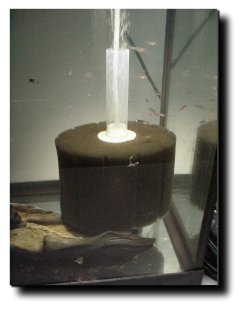 Sponge filters and just about any small biofilter that would be suitable for Q or T tank purposes, can be “stored” in the main pond to provide additional biofiltration, while keeping them cycled and ready for use in a Q or T tank situation. This way, you’ll never find yourself short of a cycled filter when you need one. Also, Doc Johnson has some good information on “rapid starting” biofilters, on the KoiVet web site. If you don’t want to keep a “spare” biofilter in the main pond, you can use his information to get the new biofilter up in running in short order.
Sponge filters and just about any small biofilter that would be suitable for Q or T tank purposes, can be “stored” in the main pond to provide additional biofiltration, while keeping them cycled and ready for use in a Q or T tank situation. This way, you’ll never find yourself short of a cycled filter when you need one. Also, Doc Johnson has some good information on “rapid starting” biofilters, on the KoiVet web site. If you don’t want to keep a “spare” biofilter in the main pond, you can use his information to get the new biofilter up in running in short order.
The small bead filter, or even a small, high-rate sand filter offers both mechanical and biological filtration. But just like the main pond’s filter, *any* biofilter will function more efficiently when it is not expected to do both jobs associated with pond filtration, mechanical and biological.
The trickle tower is a good type of biofilter for quarantine tank use, as it adds greatly to the oxygen content of the water. I consider the Low Space Bioreactor to be a “submerged analog” to the TT, and quite suitable for QT systems. But neither of these biofilters was designed to provide any mechanical filtration, at all. *None*. Both must have a good mechanical filter in-line, ahead of them.
Koi Food & Feeding
What should you feed your koi? How many times per day? Is Corn really that bad in a Koi diet? What are the most common feeding mistakes people make? What’s the best food?
A quarantine tank of newly purchased Koi would *not* be the proper place to try out one of the “bugs-in-a-bottle” concoctions to cycle a biofilter, unless you’ve used it before and have seen it actually *work.* One bacterial additive product I *do* like to use in a quarantine situation is KoiZyme and double-dosed at that. KoiZyme will not prevent all your bacterial problems, but it will greatly reduce them.
If you have a UV that can be used on the QT tank, by all means, use it. I’m not so sure I’d run out and buy one just for this, however. If you do, consider getting one at least *twice* the size recommended by the manufacturer, and run it with only *half* the flow rate that would normally be used with a UV that size. This way you just might get into the range that would offer some serious bacteria killing properties.
However, do be aware that many treatments require that the UV be shut off while the treatment is active in the pond. It may “de-activate” some treatments, and could cause some chemical compounds to become toxic to the fish.
Aeration
Aeration, or, getting oxygen into the water, can be accomplished in several ways. The most effective way is by using a spray bar as a water return from the filter system. A spray bar is nothing more than a capped pipe with a series of holes drilled into it. Instead of a single column of water gently returning to the tank, the spray bar gives you a number of small “jets” of water that impact and disrupt the surface of the water.
A foaming fountainhead is nothing more than a venturi. These fountainheads add a lot of aeration to the water. I use one attached to a short length of garden hose to aerate water from a well, when adding water to a pond. (Flooming)
Adding air stones is always a good idea, but they do not add as much oxygen to the water as a spray bar. One additional benefit from placing an air stone in the bottom of a tank is that the rising column of bubbles will help “turn the water over.” The surface disturbance produced by that column of bubbles can give the fish a sense of security, in that the disturbed water is hard to see through. And that surface disturbance is where most of the aeration from an air stone really takes place.
A submerged venturi placed on the water return can be used. Some water treatments can be poured into the air intake of the venturi, giving you a good, fast method of mixing it into the pond water.
Solids Removal
Most of the time, solids removal in a QT system can be accomplished quite simply, by putting an over-sized sponge filter on the submersible pump’s intake. This can be cleaned, as often as needed, without regard to removing any “beneficial bugs,” as it’s purpose is mechanical filtration, only.
Larger QT systems may require a mechanical filter more along the lines of what would be found on the main pond. But since the QT system is usually going to be much smaller than the pond itself, methods of solids removal that might not be practical on the pond can and should be considered. These methods include cartridge filters, bag filters, and sand or diatomaceous earth filters.
Solids production should not be as pronounced as in a pond, but solids removal cannot be ignored. If you are using a biofilter such as a pressurized bead filter, you may not need to add mechanical filtration, *provided* the bead filter is sized properly, knowing that it will be performing *two* totally different functions at the same time. But a bead filter, just like any other biofilter, will work more efficiently when it is fed mechanically clean water. This holds true in any application, QT or on the main pond.
Heat
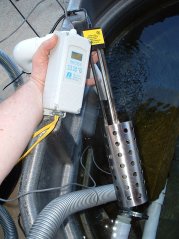 As stated above, water temperature is critical when using antibiotics. They simply will not get the job done when the water is too cold! You must be able to keep the water in a QT system within the range of 74*F to 78*F range, for the best results. Colder than that, it will be almost impossible to beat a bacterial infection. At higher temps, water simply is not capable of holding much oxygen and oxygen depletion can easily occur. Remember that some treatments can consume *large* quantities of oxygen!
As stated above, water temperature is critical when using antibiotics. They simply will not get the job done when the water is too cold! You must be able to keep the water in a QT system within the range of 74*F to 78*F range, for the best results. Colder than that, it will be almost impossible to beat a bacterial infection. At higher temps, water simply is not capable of holding much oxygen and oxygen depletion can easily occur. Remember that some treatments can consume *large* quantities of oxygen!
In Summation
Quarantine and treatment tanks should not be considered a “luxury” item. They need to be thought of as an integral part of good Koi keeping practice. These systems can be as simple or as elaborate as you care to make them. But the basic requirements do not change. They must WORK! There are two different hobbies you can choose from, Koi keeping and “fish fixing.” Ignore the need for proper quarantine and treatment tanks, you’ll eventually find yourself as part of the latter, rather than the former version of the hobby.
Koi keeping is a *lot* more fun!
Mike S.
Spring Hill, FL
Sometimes Koi don’t give you the time to let them rest before you have to deploy treatments. For example; if your fish came in with Costia (Ichthyobodo) they will be “sick” and sliming up in just a few days – immediate treatment supercedes the custom of “rest” which Mike aptly suggests. In other cases, if the fish start showing signs of KHV or other gill lesions, one might be well advised to accelerate a warming process to the low eighties to hamper the virus by departing its optimal effective temperature range. So, there are variables which require case-by-case judgement calls.






